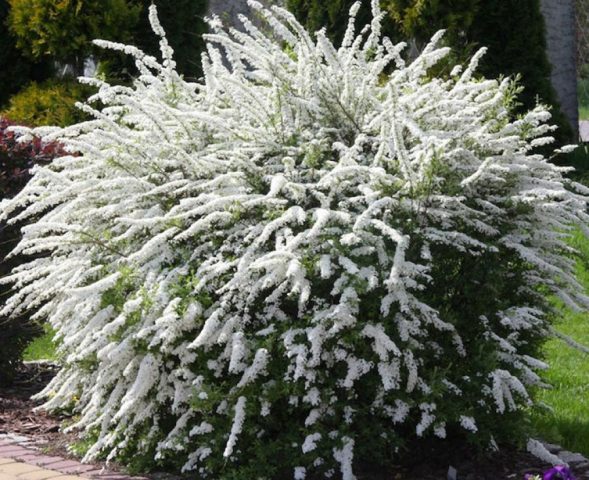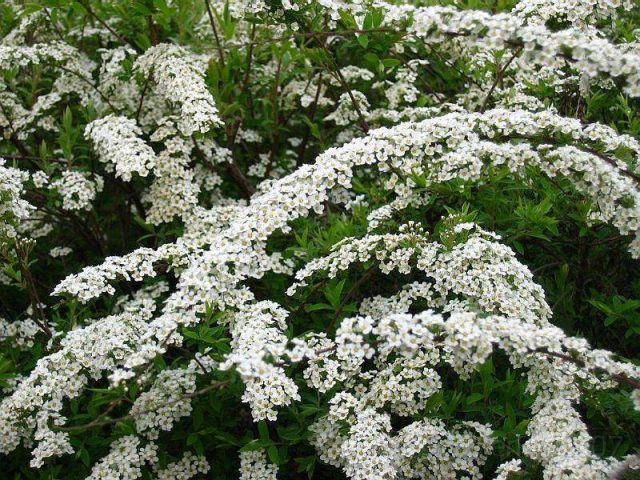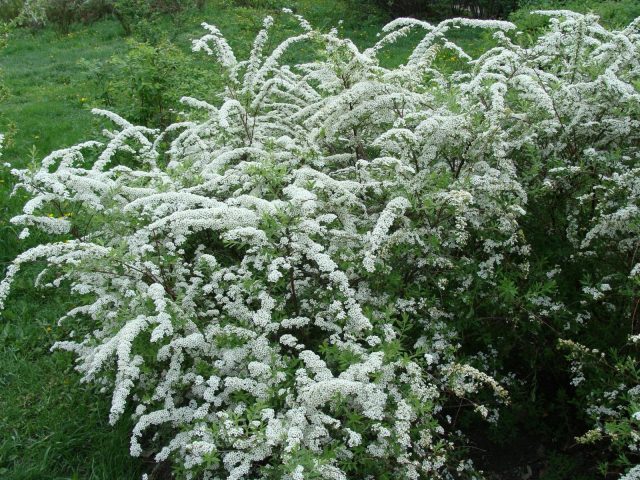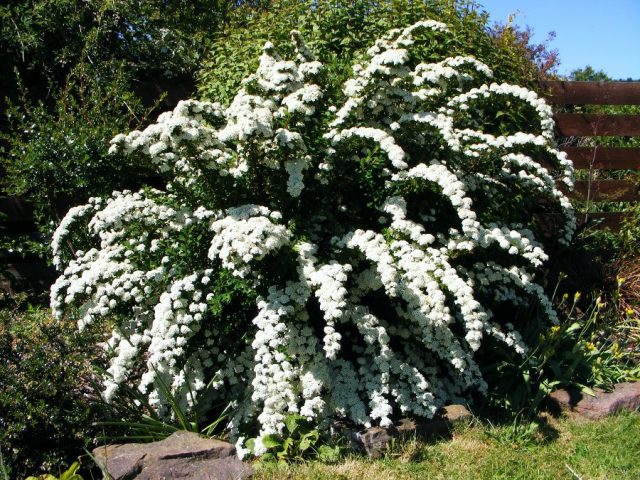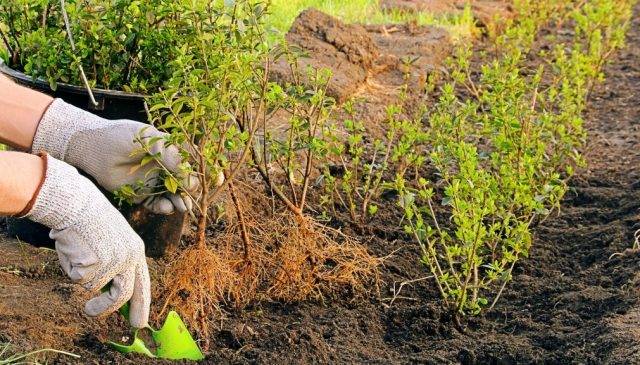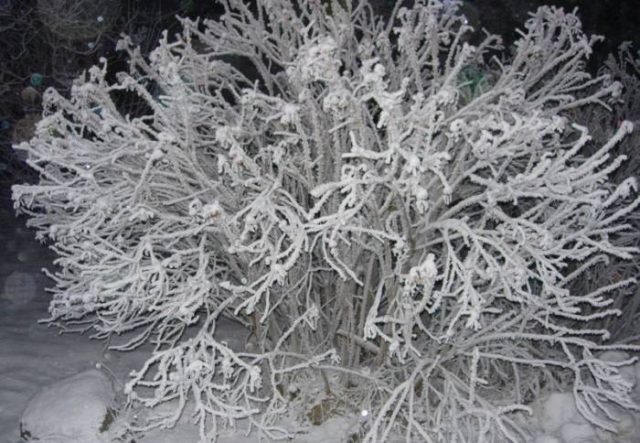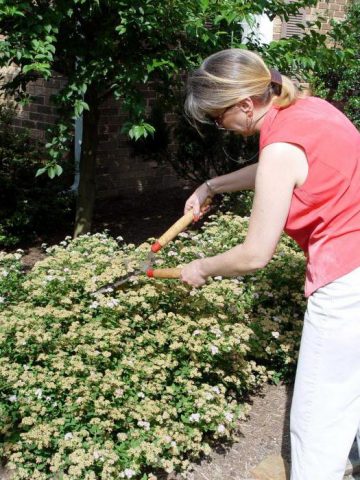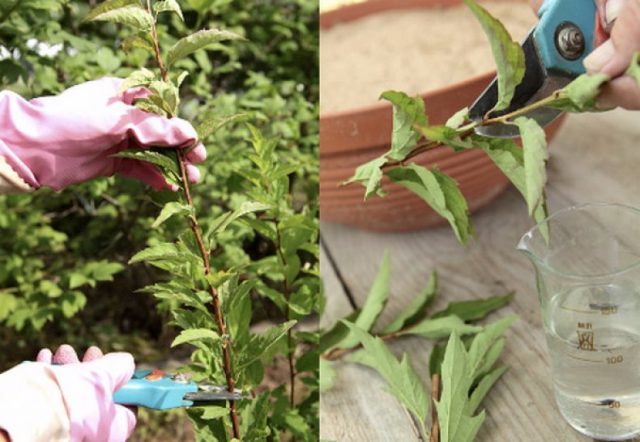Content
Spirea gray Grefsheim is a deciduous shrub belonging to the Rosaceae family. The genus of these plants is quite extensive, without any particular difficulties amenable to interspecific crossing. In the course of the breeding experiment, two varieties were used: Zverobolistnaya and Belovato-gray. Thus, in 1949, a new hybrid species appeared in Norway - Spiraeacinerea Grefsheim.
Due to its extraordinary properties, it is used to decorate household plots, gardens, parks. Landscape designers prefer the Grefsheim hybrid for aesthetics and variability, and gardeners for minimal maintenance.
Description of gray spirea
Spirea gray Grefsheim is a branched, fast-growing, long-flowering shrub. Grows up to 2 m in height and width. At the same time, the crown is quite compact, spherical in shape. Branched shoots, tomentose-pubescent. Leaves 4 cm long, 1 cm wide, lanceolate, pointed at the ends. The edges of the plate are smooth. The plant got its name because of the gray shade of the leaves. They turn yellow only in autumn.
Spirea flower Grefsheim has a diameter of up to 1 cm. The shade of terry petals is snow-white. Inside there is a yellow center. All flowers are collected in umbellate inflorescences, which cover the shoots very densely. The flowering period begins in May and lasts 1.5 months. After that, small fruits are formed on the Grefsheim hybrid.
The features of the Grefsheim gray spirea variety are:
- high growth, branches grow by 25 cm annually;
- good honey plant, attracts many pollinating insects to the site;
- drought resistance and frost resistance, belongs to the 4 climatic zone;
- painlessly tolerates a haircut;
- endurance to urban smog, dust;
- unpretentiousness to lighting.
Spirea gray in landscape design
In landscape design, gray Grefsheim is used in different ways, it all depends on the imagination of the site owner or designer. A hedge can be planted along the paths or used as a fence, then it will simultaneously function as a fence and decor. It easily disguises garden supplies, be it irrigation barrels or storage equipment.
The Grefsheim hybrid is also used for single plantings. For example, in the center of a meadow with a lawn, near the porch, creating a bright accent for an alpine slide. The classic style involves planting gray Grefsheim spirea near water bodies.
It is difficult to find plants with which gray Grefsheim spiraea would be poorly combined. It looks great with undersized ornamental shrubs: euonymus, broom, viburnum. You can plant the Grefsheim hybrid variety next to tulips, daffodils, primrose, crocuses.
Varieties of gray spirea
To date, more than 100 varieties of spirits are known.They differ in size, flowering period, color. Among the most popular varieties of gray spirea are ash Grefsheim, gray Arguta, Graciosa, the external individual characteristics of which can be seen in the photo.
Spirea ashy Grefsheim
Shrub 1.5 m high. The crown of the plant, at first glance, resembles a snow-white ball. The spectacular Grefsheim hybrid is distinguished by its dense, constant presence of flowers. Leaves are ash-green or bronze-yellow in color. The color of the inflorescences can be pink, red, white. It is the most compact among the rest of the species.
Spirea gray Arguta
Arguta has been known since 1884. The popular name is "Foam Maya". It is covered with flowers in the second half of April. The crown is voluminous. Flowers are formed on shoots last year, diameter 0.5-0.8 cm, white. Belongs to the 6th climatic zone. Prefers fertile soils. Light-loving culture. Looks good in combination with conifers.
Spirea gray Graciosa
A graceful shrub with sprawling, arched branches. Height 1.5-2 m. Leaves are narrow-lanceolate, green. Flowering is long and lush. The flowers are collected in umbellate inflorescences, are white in color. The character is unpretentious. The subspecies has high indicators of drought and frost resistance.
Planting and caring for sulfur spirea
Gray Grefsheim has no special requirements for planting and leaving the spirea. You just need to take into account the recommendations described below.
Landing dates
Experienced gardeners say that planting gray Grefsheim spiraea is best done in the fall. When the trees are losing their foliage, but not too cold yet. Tentatively, this is the second mid-September. Before the frost begins, the seedling will have time to get stronger and settle in a new place, and with the arrival of heat it will grow.
Of course, planting gray Grefsheim spirea in open ground can be done in the spring. Only have time before bud break. It has been noticed that the seedlings of the Grefsheim hybrid take root in the best way in rainy or cloudy weather.
Preparation of planting material and site
A well-chosen place makes it possible for gray Grefsheim to grow for more than a dozen years. The main requirement is good illumination. The landing site should be in a secluded corner, protected from cold winds and drafts. In the description of the variety, it is indicated that gray spirea Grefsheim is capable of growing in partial shade, but in this case the rate of development will slow down significantly. The sun should evenly illuminate the area, otherwise the crown will be one-sided.
The bush of the Grefsheim hybrid grows well in loose, light soils. The presence of micronutrients is preferred. It is possible to enrich depleted land with the help of a sod substrate, humus, peat, and sand will give lightness to the soil. A neutral acidity level is also required. An equally important nuance for the full development of gray Grefsheim spirea is the organization of the drainage layer.
When buying a gray Grefsheim spirea seedling, it is worthwhile to carry out a visual inspection. High-quality planting material has no foliage, blackness and cuts. The roots are moist and flexible. If the plant is sold in a container, then the root system should not come out through the drainage holes. The similar says that the cutting is stale, it will take root for a long time.
Before planting the seedlings of the Grefsheim hybrid, it is necessary to remove excess soil. If there are fossils, it is worth leaving them in a container of water for several hours. Be sure to carry out preparatory activities:
- shorten long and damaged roots;
- the size of the shoots should be reduced by 30% of the total length.
How to plant gray spirea
When forming a depression, it is important to take into account that the size of an adult bush of gray spirea Grefsheim has a sufficiently developed root system.The planting area will be large, and the dimensions of the pit will exceed the volume of the roots by 2 times.
It is advisable to dig a depression a couple of days before the planting procedure, so that the walls of the hole have dried.
- Crushed stone, expanded clay, pebbles are laid at the bottom with a layer of 10-15 cm.
- A mixture of peat and sod land is poured on top.
- In the center of the groove, a sapling of sulfur spirea is placed and the roots are carefully straightened.
- Sprinkle with earth and lightly tamp.
- Pour 20 liters of warm water into the periosteal circle.
- After absorbing moisture, the near-stem section is covered with mulch with a thickness of 5-10 cm.
The first flowering will be 3-4 years after planting.
When planting bushes of the Grefsheim variety in groups, the distance is 0.8 m.
Watering and feeding
Like other varieties, Grefsheim gray spirea has a verstal root system. It reacts poorly to a lack of moisture. Leaves immediately begin to wither, the growth rate slows down. But excess water will not be good for the Grefsheim hybrid. Constant exposure to a humid environment will lead to root rot.
In order for the water regime to be normal, it is enough to water gray Grefsheim with spirea twice a month, 15 liters for each plant. During a long absence of rain, the frequency of humidification should be increased and the procedure should be performed twice a week.
It is recommended to please the spirea bush with gray Grefsheim with nutrients several times per season.
- The first time is fertilized with gray spirea after spring, preventive pruning, but before flowering. Use preparations containing nitrogen, which will stimulate the growth and build-up of green mass.
- The second time - during the budding period, to obtain a beautiful and lush flowering. Potash-phosphorus fertilizers are used for this purpose.
- The last time is after the end of flowering. Organic fertilizers, poultry manure or superphosphate mullein are preferred.
Formation of sulfur spiraea
The formation of gray Grefsheim spirea consists in the correct pruning of the bush. This procedure is quite complicated and can take several years. Every fall, 5-6 strong, healthy shoots are chosen, the rest are removed. After flowering, weak branches are cut. Thus, after 2-3 years, only strong branches will remain, which will form the crown of the gray spirea.
Do I need to shelter for the winter
Depending on the variety, the ability to withstand winter changes. Spiraea gray Grefsheim can withstand air temperatures up to - 50 ° С without any special losses. From this it follows that there is no need to provide shelter for the winter. The only thing that shrubs do not like are sharp and frequent weather changes. Therefore, in cold areas, experts advise mulching the peri-stem circle.
Preparing gray spirea for winter
Young shoots may not tolerate the cold and die. In the northern regions, Siberia, in order to protect the gray Grefsheim spirea, further care should be properly carried out after the autumn planting.
- Cover the trunk circle with dry foliage or grass with a layer of 10 cm.
- Collect shoots in a bunch.
- After the branch, bend it to the ground and secure it with a metal peg.
- The top is covered with a village and straw.
- Sealed with agrofibre or burlap.
Pruning gray spirea
Pruning is the main element of caring for sulfur spirea. It helps to maintain the decorative properties of the shrub at the proper level, stimulates further growth, lush flowering.
When trimmed with gray spirea
The procedure is carried out in spring and autumn. After winter, dry, frozen branches are removed, performing sanitary pruning. The Grefsheim hybrid is characterized by rapid growth, soon new shoots appear in their place. The formation of many shoots gives the density of the sulfur spirea bush.
As a rule, the second pruning of the Grefsheim spirea is planned in the fall, after flowering. Lost, diseased branches are also removed, and the remaining shoots are shortened. At this time, it is recommended to perform a rejuvenating haircut. Absolutely all branches are cut off, leaving a stump with dormant buds at the base. It is from them that young shoots will grow.
How to prune gray spirea after flowering
- The first haircut of gray Grefsheim spirea occurs 2 years after planting, not earlier.
- The branch develops up to 4 years, and then dries up. If not pruned regularly, the bush will dry out.
- After the age of seven, a rejuvenating procedure is performed, which involves pruning branches at the root.
- The main pruning of the spirea shrub gray Grefsheim should be after the end of flowering.
- Adults undergo a haircut by 25%, young ones - shorten the branches.
- You can not leave shoots only of the same age. In the future, the gradual dying off will affect the appearance of the spirea shrub Grefsheim gray.
- After the first flowering, weak shoots are cut off.
- If the main procedure is performed on time, namely in the fall, then in the summer the plant will delight you with a beautiful flowering.
Reproduction of sulfur spirea
Hybrid gray spirea reproduces in three main vegetative ways:
- dividing the bush;
- layering;
- by cuttings.
How to propagate gray spirea from a bush
The division of the bush is carried out in the fall during the transplantation of sulfur spiraea. The Grefsheim hybrid is carefully removed from the soil, the root system is cleaned to see the place of division. You need to divide the roots into 2-3 parts using a garden pruner so that each part has two full-fledged shoots and a healthy lobe. If during the procedure it was necessary to harm their integrity, then it is better to immediately treat the place with a fungicide solution.
How to propagate by cuttings
Reproduction of spirea gray Grefsheim is considered the simplest, most effective and popular way. Most gardeners practice this method. As a rule, blanks are made in September-October. Choose an annual, healthy shoot. He must certainly be stiff, direct. Then cut into cuttings, each with 4-5 leaves. The main part of the greenery is removed, and the top is cut in half.
In Epin's solution (1 ml per 2 l of water), the prepared petioles are left overnight. Then they are planted in wet sand. However, it should be noted that the sprouts must be positioned at a 45 ° angle. It is in this position that roots grow from the lower internode.
It is better to take the container with the planting out into the garden and cover with a transparent cap. While the weather is warm, spray the plants every other day. With the onset of frost, an inverted box is put on top and covered with dry leaves. In the spring, with the appearance of spiraea, gray Grefsheim is transplanted to the beds for growing.
How to propagate by seeds
Spirea gray grefsheim is a hybrid variety. The seeds are not suitable for planting with further propagation. They do not carry genetic information. Therefore, the seed method is not suitable for breeding this variety.
How to propagate by layering
The layering method is simple to perform and is often in demand. In early spring, before the foliage appears, it is necessary to bend the side shoots to the ground. To deepen some of them. Along the length, the shoot of the gray Grefsheim spirea is pinned with metal pegs. By the fall, a full-fledged root system usually appears. Therefore, it is possible to separate the rooted shoot from the mother plant and transplant.
Diseases and pests
When growing a Grefsheim hybrid on a personal plot, there is a chance to meet uninvited guests, in particular, garden snails, aphids, spider mites. They cause a lot of problems, so the gardener needs to regularly examine the gray Grefsheim spirea. The sooner pests are detected, the easier it will be to deal with them.
For prevention purposes, they are treated with a biological preparation Fitoverm, which will destroy slugs when they appear and protect the plant from possible ailments.
Young shoots of the Grafsheim hybrid are attractive to aphids. Colonies of this insect inhabit the underside of the leaf and feed on the sap of branches and leaves. You can eliminate them using chemical treatment. Among insecticides, Pirimor and Actellik have proven themselves well. On minor accumulations of aphids, you can influence the infusion of wormwood, celandine, hot pepper.
Spider mites inflict serious damage on the Grefsheim hybrid. The plant takes on an unhealthy appearance, there are numerous holes on the leaf plate, untimely yellowing and flying around of the leaves. In the fight against spider mites, Karbofos and Akreks will help.
In rare cases of spirea, Grefsheim suffers from infections: ascochitis, septoria or ramulariasis. Large numbers of gray spots appear on the foliage. In this case, treatment will help only at the initial stage of the disease. When symptoms have just begun to appear, the Grefsheim hybrid should be treated with colloidal sulfur, Bordeaux liquid or Fundazol.
Conclusion
Spirea gray Grefsheim is an aesthetically beautiful shrub that is easy to grow and attractive in appearance. It will fit perfectly into any landscape composition. At the same time, it will take a minimum of effort and time from the gardener, but it will give white fireworks in the form of delicate, flowing shoots.
